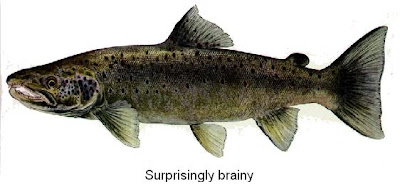Nature has a disturbing article from their Asian correspondent David Cyranoski: Thought experiment. It's open access.
The technology was approved by the Japanese authorities in April 2009, and since then it's been used on at least 300 patients, who pay $160 for the privilege. However, it's not clear that it works.
To put it mildly.
It's a lot cheaper and easier than MRI. However, the images it provides are a lot less detailed, and it can only image the surface of the brain. NIRS has a small but growing number of users in neuroscience research; it's especially popular in Japan, for some reason, but it's also found plenty of users elsewhere.
The clinical use of NIRS in psychiatry was pioneered by one Dr Masato Fukuda, and he's been responsible for most of the trials. So what are these trials?
As far as I can see (correct me if I'm wrong), these are all the trials comparing patients and controls that he's been an author on:
- Matsuo et al (2000) n=9/10 elderly depressed/controls
- Suto et al (2004) n=10/13/16 depressed/schizophrenia/controls
- Kameyama et al (2006) n=17/11/17 bipolar/depression/controls
- Nishimura et al (2007) n=5/33 panic disorder/controls
- Takizawa et al (2008) n=55/70 schizophrenia/controls
- Uehara et al (2007) n=11/11 eating disorder/controls
- Suda et al (2010) n=27/27 eating disorder/controls
So we have 342 people in all. Actually, a bit less, because some of them were included in more than one study. That's still quite a lot - but there were only 5 panic patients, 30 depressed (including 9 elderly, who may be different), 38 eating disordered and just 17 bipolar in the mix.
And the bipolar people were currently feeling fine, or just a little bit down, at the time of the NIRS. There are quite a lot of other trials from other Japanese groups, but sticking with bipolar disorder as an example, no trials that I could find examined people who were currently ill. The only other two trials, both very small, were in recovered people (1,2).
Given that the whole point of diagnosis is to find out what any given patient has, when they're ill, this matters to every patient. Anyone could be psychotic, or depressed, or eating disordered, or any combination thereof.
Worse yet, in many of these studies the patients were taking medications. In the 2006 depression/bipolar paper, for example, all of the bipolars were on heavy-duty mood stabilizers, mostly lithium; plus a few antipsychotics, and lots of antidepressants. The depressed people were on antidepressants.
There's a deeper problem. Fukuda says that NIRS corresponds with the clinical diagnosis in 80% of cases. Let's assume that's true. Well, if the NIRS agrees with the clinical diagnosis, it doesn't tell us anything we didn't already know. If the NIRS disagrees, who do you trust?
I think you'd have to trust the clinician, because the clinician is the "gold standard" against which the NIRS is compared. Psychiatric diseases are defined clinically. If you had to choose between 80% gold and pure gold, it's not a hard choice.
Now NIRS could, in theory, be better than clinical diagnosis: it could provide more accurate prognosis, and more useful treatment recommendations. That would be cool. But as far as I can see there's absolutely no published evidence on that.
To find out you'd have to compare patients diagnosed with NIRS to patients diagnosed normally - or better, to those randomized to get fake placebo NIRS, like the authors of this trial from last year should have done. To my knowledge, there have been no such tests at all.
 So what? NIRS is harmless, quick, and $160 is not a lot. Patients like it: “They want some kind of hard evidence,” [Fukuda says], especially when they have to explain absences from work. If it helps people to come to terms with their illness - no mean feat in many cases - what's the problem?
So what? NIRS is harmless, quick, and $160 is not a lot. Patients like it: “They want some kind of hard evidence,” [Fukuda says], especially when they have to explain absences from work. If it helps people to come to terms with their illness - no mean feat in many cases - what's the problem?My worry is that it could mean misdiagnosing patients, and therefore mis-treating them. Here's the most disturbing bit of the article:
...when Fukuda calculates his success rates, NIRS results that match the clinical diagnosis are considered a success. If the results don’t match, Fukuda says he will ask the patient and patient’s family “repeatedly” whether they might have missed something — for example, whether a depressed patient whose NIRS examination suggests schizophrenia might have forgotten to mention that he was experiencing hallucinations.Quite apart from the implication that the 80% success rate might be inflated, this suggests that some dubious clinical decisions might be going on. The first-line treatments for schizophrenia are quite different, and rather less pleasant, than those for depression. A lot of perfectly healthy people report "hallucinations" if you probe hard enough. "Seek, and ye shall find". So be careful what you seek for.
While NIRS is a Japanese speciality, other brain-based diagnostic or "treatment personalization" tools are being tested elsewhere. In the USA, EEG has been proposed by a number of groups. I've been rather critical of these methods, but at least they've done some trials to establish whether this actually improves patient outcomes.
In my view, all of these "diagnostic" or "predictive" tools should be subject to exactly the same tests as treatments are: double blind, randomized, sham-controlled trials.


 15.20
15.20
 wsn
wsn
 Posted in
Posted in 














